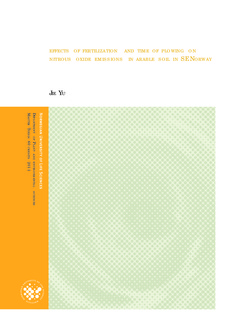| dc.description.abstract | The agricultural sector has been identified as a major anthropogenic source for the greenhouse gases N2O, CH4 and CO2 by the Intergovernmental Panel on Climate Change (IPCC, 2007). Although N2O only accounts for around 0.03% of total greenhouse gas emission, its radiative
forcing is much higher since it absorbs 310-340 times more radiation than CO2. Therefore the effect of cultivation strategies on soil borne N2O emissions is an important issue for reducing greenhouse gas (GHG) emissions from food production. In the present study, N2O emissions
were measured in a long-term (since 1989) agricultural plot trial on a clay soil on the campus of Norwegian University of Life Sciences in Ås, comparing the combined effect of fertilizer rate and spring versus autumn plowing on cereal yields. N2O emissions were measured
periodically throughout the growing season 2010 using a static chamber method. Integrated over the measurement period (April to October 2010), cumulative N2O emissions clearly increased with increasing fertilizer rate (0-120 kg N ha-1 yr-1). Although not perfectly linear, the increase in cumulative N2O emissions suggested that ~1% of the applied N is lost as N2ON
which is identically to the Tier 1 emission factor devised by IPCC (2007) for national GHG inventories. Time of plowing had no significant effect on N2O emissions when integrated over the entire growing season. However, seasonal fluxes showed that emis sions were higher in spring plowed soil before plowing as compared with soils that had been plowed in the previous autumn, presumably because autumn plowing leads to more N loss throughout winter. The opposite was the case after spring plowing, i.e. soils that were not plowed in
spring had higher emissions which might have been associated with plowing- induced changes in soil structure. Together, both effects cancelled each other out so that no effect of plowing time could be seen on an annual basis. Irrespective of the mechanisms involved, it may be
concluded that permanent (> 30 years) spring versus autumn plowing had no fundamental effect on N2O emission in the studied soil, suggesting that time of plowing is not a relevant tool for mitigating fertilizer induced N2O emissions. On the other hand, this means that the plowing time can be chosen to meet other environmental goals (e.g. erosion control) without
jeopardizing the goal by undesirable effects on N2O emissions. | no_NO |
